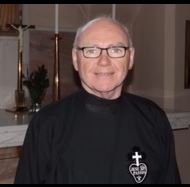At the beginning of this week in St. Mungo’s, we celebrated the Feast of Saint Gabriel of Our Lady of Sorrows, the young Italian Passionist student who died in 1862, just two days short of his 24th birthday. He is one of the church’s patrons of youth, as well as being the patron of Passionists who are in the initial stages of formation. At present, in our own St. Patrick’s Province of Ireland and Britain, we have three young men in initial formation: our student Connor; our novice Cian, and our postulant Niall. All three are Irish. The statue of St. Gabriel in St. Mungo’s stands on the same side of the church as the shrine to Our Lady of Sorrows, to whom he had an extraordinary devotion. Until quite recently the place where every Passionist began his formation in St. Patrick’s Province was at St. Gabriel’s Retreat in Enniskillen. I started there myself in October 1975, after finishing accountancy studies, and giving up my job in Olivetti, and I was reminiscing on that during these past few days.
There were two of us joining from Scotland that year. We were collected at our family homes by Brother Brendan and brought down to the retreat house at Coodham in Ayrshire. From there we were driven via the Ardrossan- Belfast ferry down through the north west of Ireland, passing through places such as Augher, Clogher, and Fivemiletown, in South Tyrone, heading for County Fermanagh. There were no helpful motorways in those days, and so the journey took a long time. I remember seeing the rather imposing monastery from a distance as we drove the three miles out of Enniskillen, and then turning into the driveway to begin a new life. We were greeted by the Postulancy Director, Father Bernard, dressed in full habit and mantle. He looked a bit stern and I thought he was ancient, but in fact he was only 55. In truth he really was a bit stern, but he was also a very good and holy man. We were introduced to our other classmates, two from Belfast, one from County Clare, and the other from Nigeria. Initially, accents were a bit of a problem to communication, but we gradually overcame that.
I was shown to my room, in monastic terms my cell. It was very stark; a bare light bulb hung from the ceiling; there were no curtains, only shutters on the window; there was an old iron-framed bed with a mattress that had seen better days, more of a hammock really, with a sheet and a couple of threadbare blankets. There was a small desk and chair, and a wardrobe that needed a folded piece of cardboard to keep the door closed. There was a crucifix on the wall, and a portrait of St. Gemma Galgani. This was to be my new home for the next 12 months. I lay in bed on the first night wondering what I had done.
We followed a very strict Horarium, with almost every moment of the day being accounted for, from the time we rose for Morning Prayer, until the time we went to bed after Night Prayer. There were fixed times for class and study, and a variety of chores, both inside and outside of the retreat to keep us occupied. Being a city boy, garden work and planting trees was not my strong suit, but I had to learn. There was also a farm attached to the retreat, and on occasion we would be asked to assist with things like bringing in the hay, which was also new to me, and back-breaking, as I quickly discovered.
On a Thursday we would go out to visit a number of housebound people, and people in nursing homes, which necessitated me learning to ride a bike. I was 24 years of age and had never ridden a bike beyond the 3-wheeler we shared as kids. The people living in proximity to the monastery had great fun watching my initial efforts, crashing and remounting, crashing and remounting, but eventually I mastered it, which was rather essential as, when I would move on to Dublin to begin studies the following year, that would be the required mode of transport for getting to university.
We had a few hours off on a Saturday afternoon, when we could walk into town and potter around Enniskillen. I was asked to take on a children’s choir for Sunday Mass and, arising from that, I was also asked to take catechetics classes for sacramental preparation for catholic children who were attending a non-denominational school. Father Bernard was also into Charismatic Renewal at the time. We had a big meeting in the retreat on a Thursday night at which I would play guitar, and he would also as me to bring the guitar to other meetings in outlying country areas. Those were nice diversions from the usual fixed routine. On the Feast of St. Gabriel, we were treated to a day out in Bundoran, accompanied by our director, which we all enjoyed, although February was a bit too cold for the beach. We had an hour’s recreation in the evening but were only allowed to watch the news on TV, and Match of the Day on a Saturday night. All in all, it was a quiet, simple, prayerful life, but also a very blessed time that I will always remember and be grateful for. It’s all very different now.
As ever, protect yourself, your loved ones and others, and protect Christ in your lives.

 RSS Feed
RSS Feed
